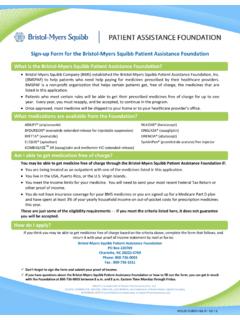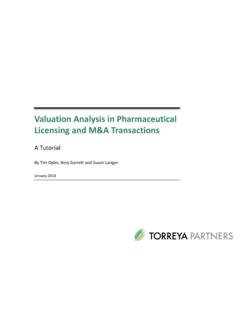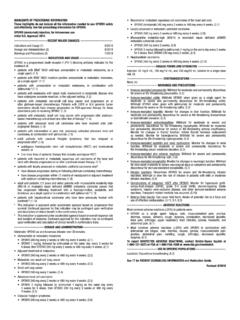Transcription of Bios of panelists for data science 050217 - Rutgers iJOBS
1 iJOBS Career Panel: Data science Tuesday May 2, 2017 4:30- 6:00pm 679 Hoes Lane West CABM 010 Piscataway, NJ There are 4 types of data that companies need people to mine: 1) Clinical data 2) Real world data 3) Pre- clinical data 4) Next gen sequencing There are 3 vertices that will make you a successful data scientist: 1) Statistics 2) Subject matter expertise 3) Database skill (R, python, SAS, sequel) Useful skills and future directions of the field now include: Data wrangling taking raw data and making it useful Data integration taking data from multiple sources to analyze Natural language processing (NLP) is when you mine free text answers (qualitative) that clinicians enter into a patient chart to make quantitative.
2 Cognitive computing Machine learning If you don't have any experience in industry or with data science then you can 1) Analyze some data that you find on NCBI to demonstrate you have the skills. You can bring that analysis to the interview. There is so much data out there that you don't need to create new data sets. 2) Collaborate with a statistician on your research project so that you can learn from them and include that experience in your resume. 3) Easiest way to get an entry level job is at a contract research organization (CRO). They are willing to train people. 4) Do a first or second postdoc in a computational lab. 5) Get an MS in biostats 6) Do an internship at a company that is not life science such as IBM, one of the national labs, Tesla etc 7) Get a certificate in biostats Certificates Three SAS certificates all of which have exam content guides.
3 SAS Certified Base Programmer for SAS 9 SAS Certified Advanced Programmer for SAS 9 SAS Certified Clinical Trials Programmer Using SAS 9 Courses in big data, statistics and epidemiology Coursera data Stanford Medicine courses- training American Informatics Association is a 10 week course courses Jane Zhang, PhD Associate Director Biostatistics Allergan, LLC Bridgewater, NJ 908- 203- 2702 Jane Zhang is an Associate Director in Biostatistics, Allergan, LLC. She joined Allergan in 2013. Prior to joining Allergan, she was a statistician in Bristol Myers Squibb company. Dr. Zhang received her degree from Rutgers University in Statistics. After graduation in 2008, she started working as a biostatistician in the pharmaceutical industry.
4 She has published several research papers on both statistical and clinical research topics. Her current statistical contributions focus on drug clinical development. She has worked on clinical trials across early to late phases and with experience in various therapeutic areas (TAs), including ophthalmology, dermatology, cardiology, metabolism, oncology, and neurology. round in materials science and biomechanics. Yodit Seifu, Senior Project Statisitician Ferring Pharmaceuticals 100 Interpace Parkway Parsippany, NJ 07054 862- 286- 5194 Yodit received PhD in Statistics in 1995 from the University of Toronto. From 1995 to 1996, she completed two postdoctoral fellows at Northwestern University and North Carolina State University, respectively.
5 After working for a year as an Assistant Professor in Statistics at University of New Brunswick, she left academic work and started her industrial career at Wyeth in Rochester, New York. After moving to New Jersey at the end of 1999, she joined Novartis pharmaceutical in 2000, providing statistical support for Phase I- IV clinical trials in different therapeutic areas. Primary therapeutic area supported included oncology, endocrinology, urology, transplantation and cardiovascular disease. In 2013 she moved to Allergan to support urology therapeutic area. Currently she is at Ferring Pharmaceutical, supporting gastroenterology and fertility therapeutic areas.
6 She has experience in a number of health authority filings and in the past has participated in TransCelerate work streams. She also has experience working in DIA statistical work streams. Ariella Sasson, PhD Research Scientist Bristol- Myers Squibb Ariella Sasson majored in mathematics, bio- mathematics and computer science during her undergraduate work here at Rutgers and the came back for a PhD in Computational science and Molecular Biophysics. While working on her PhD she received the Department of Energy Computational science Graduate Fellowship which allowed her to start her career in Next Generation Sequencing. Between her stints as a student she worked as a software designer and actuary.
7 After receiving her doctorate, Ariella, worked at the Children's Hospital of Philadelphia as a bioinformatics scientist trying to identify genomic causes for pediatric diseases and developing their clinical sequencing pipeline for particular diseases. She is currently working as a research scientist at Bristol- Myers Squibb using DNA, RNA and proteomics to help develop more effective treatments for cancer and immunological diseases. When not dealing with the fast paced world of big data and sequencing, she lives in Highland Park and tries to keep up with 4 very active children. Jigar Desai, PhD US Medical Director Pfizer Oncology Jigar is currently a member of Pfizer's Predictive Analytics team, a group of data scientist that provide consultative and hands on analytics support across the drug development life cycle.
8 Before joining industry, Jigar obtained a in Molecular Genetics from Rutgers University/UMDNJ. Subsequent to his doctorate Jigar spent 5 years as a postdoctoral research fellow at Harvard Medical School where he used a translational approach integrating clinical, genetic, and cell biology methodologies to elucidate pathological mechanisms of a group of rare inherited human disorders. He published these findings in a co- first author manuscript in Neuron, which combined with work from others in the lab reclassified these human disorders. Jigar first joined pharma in a Global Medical Affairs role at Allergan Inc. working on supporting Investigator Initiated Research and Phase IV studies.
9 In 2011 Jigar joined Pfizer as Director, Predictive Analytics. In this role utilizes data driven and technology approaches that leverage clinical, observational, and real world data and innovative paradigms such as ePlacebo and eControls to support decisions across Pfizer's R&D portfolio. As a result of this work, Jigar published 2 first author and 2 second author publications in peer reviewed journals detailing advances in healthcare analytics to augment Pfizer's thought leadership and credibility in this area. Moreover, as part of his responsibilities to influence the external environment, Jigar was a key contributor and lead on two pre- competitive pharma industry consortia to forward Pfizer's strategic interests, IMI- EMIF (European Medical Information Framework) and Transcelerate (Placebo and Standard of Care Data Sharing Initiative), respectively.





